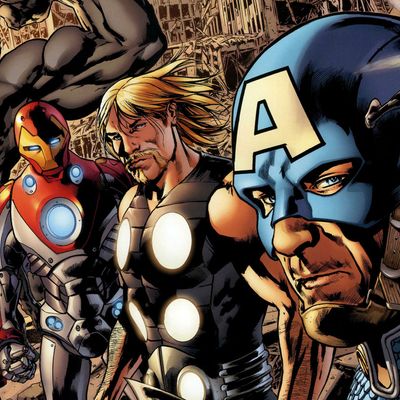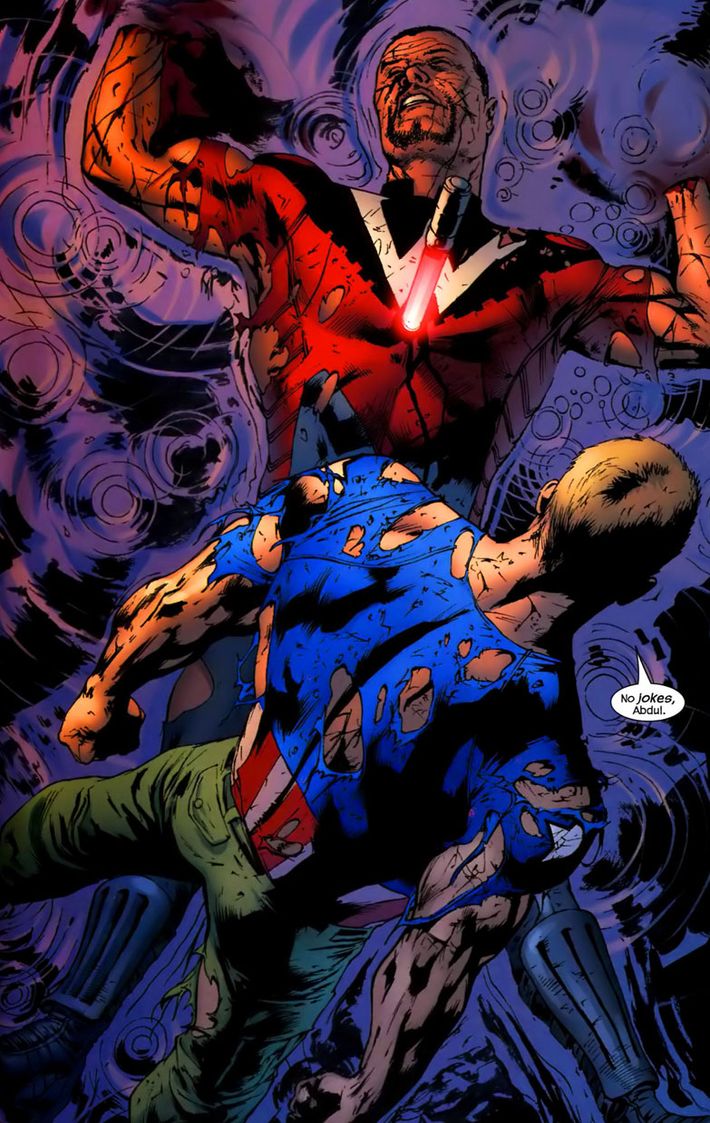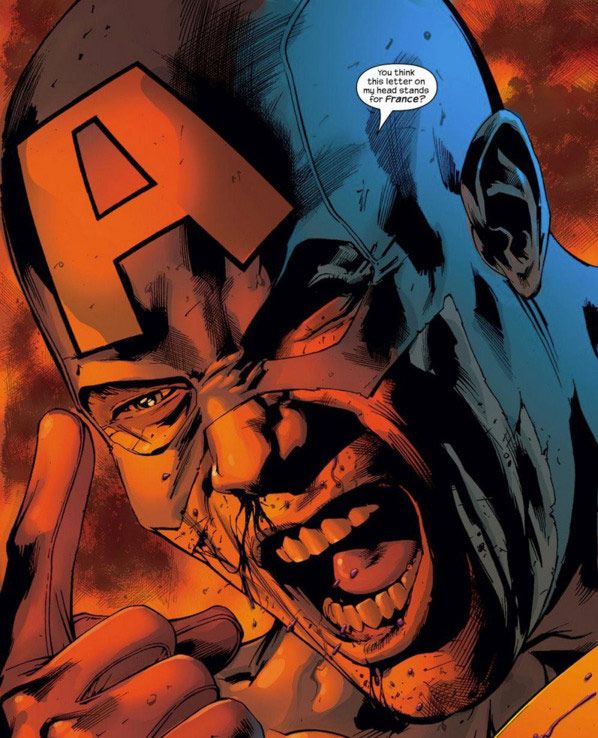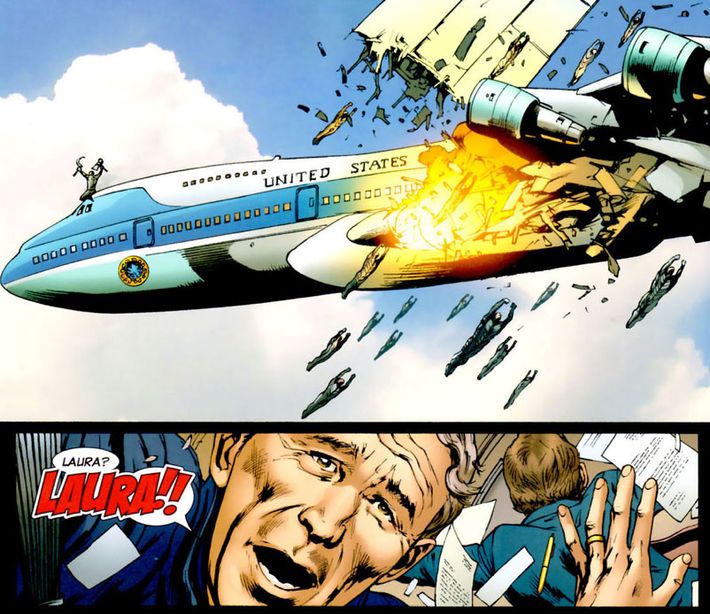
Almost exactly 15 years ago, Marvel Comics released a comic containing one of the more alarming pages they’ve ever published. In the final act of The Ultimates No. 3, Captain America — the superhero who claims to stand for all that’s good and righteous about his country — attends a Washington, D.C., gala and encounters George W. Bush. “Well, what’s your verdict on the 21st century, Captain America? Cool or uncool?” Bush asks.
“Cool, Mister President,” Cap replies. “Definitely cool.” As cameras flash, the Sentinel of Liberty proudly and enthusiastically salutes Dubya.
To look at that page today, in an era when the popular conception of Captain America is that of a morally unambiguous, charmingly hopeful figure on screens around the world, is to feel a frisson of horror. To make matters worse, the scene is free of mind control or evil cloning — Steve is doing exactly what he wants to do when he defers to the leader of the Republican Party and icon of the neoconservative movement. On one hand, it feels wholly out of character: Why would Captain America be so chummy with such a war-loving crusader? But then you think to yourself, Wait … isn’t Captain America, himself, a bit of a war-loving crusader?
The scene, like all of Ultimates, is designed to make you uncomfortable — something superhero fiction generally doesn’t do well. Written by Mark Millar and penciled by Bryan Hitch, The Ultimates was set outside of the mainstream Marvel universe, in a world that much more closely resembled our own and where the company’s classic characters were only just starting out their careers. The eponymous squadron in The Ultimates was a new-millennium riff on the characters from Marvel’s long-running superteam the Avengers, and it was equal parts thrilling and unsettling. That recipe made for one of the most remarkable stories to ever be told in the superhero genre.
That genre has evolved in a great many ways during its eight decades of existence: dialogue has become less stilted; artwork has become more varied; representation of marginalized groups has increased (though there’s still much farther to go on that front); and film, not print, has become the dominant medium for tales of paranormal derring-do. But more often than not, superhero stories on page and screen alike are designed to go down smoothly, earnestly putting us on the side of the heroes, whatever their relatable shortcomings may be. What’s more, the fundamental notion of altruistic heroism — that such a concept can even exist — is taken as a given. Those stories, themselves, are not a problem; the lack of a counterbalance is.
Thank goodness, then, for The Ultimates. This serialized epic was published by Marvel Comics in two volumes across 28 installments over the course of the aughts, with its first chapter debuting in early 2002 (there were subsequent volumes, but none done by the original creative team and all of them quite tonally different from the initial stretch). Its business impact is indisputable: The series looked and sounded like a movie in a way that no Marvel story ever had and, therefore, acted as the primary blueprint for what would later become the globally dominant Marvel Cinematic Universe. That said, a decade and a half after it exploded onto stands, its artistic and thematic legacy is much harder to parse. The Ultimates is, in a word, offensive — and that’s what makes it one of the most important superhero stories of all time. For all its flaws — and they are many — in our current entertainment and political climate, the story is perhaps more vital than ever.

Though The Ultimates played out in shocking ways, it was hardly a surprise that it quaked the firmament of the caped-crusader genre. Indeed, that was the whole point. In mid-2001, Marvel Comics was in the midst of a revolutionary experiment dubbed Ultimate Marvel. After years of financial catastrophe and artistic stagnation, company chief Bill Jemas and artist-editor Joe Quesada launched a handful of ongoing series set outside of the publisher’s labyrinthine, half-century-old thicket of continuity. These new comics reimagined top-tier characters as young people, tailor-made for the new century. First came fresh takes on Spider-Man and the X-Men, both of which were smash successes: Peter Parker was in his early teens, Aunt May was internet savvy, and Cyclops sported a truly unfortunate Fred Durst soul patch.
But though those titles were hits, they would soon be dwarfed. The ruling cabal next turned their attentions to the Avengers, another high-profile property that had been kicking around since the dawn of Marvel’s first glory years. In this bold new universe, the team bore a name that synced perfectly with the extreme-sports, nu-metal Zeitgeist: Instead of the Avengers, they’d be known as the Ultimates.
Like its predecessor titles in Ultimate Marvel, The Ultimates kept some basic names and character traits, but threw out the playbook on how they could be deployed. According to Hitch, there were prelaunch plans to simply take a more photo-realistic and narratively grounded approach to the cartoony and often-cosmic adventures of the classic Avengers. Then 9/11 happened. The world had entered a terrifying new status quo, and Hitch and Millar decided it made more sense to envision a squad created by the U.S. government to protect American blood and soil at all costs. The old Avengers had been a private club of heroes who palled around in a cheery mansion; the Ultimates were a metahuman Seal Team 6.
Accordingly, they looked and sounded strikingly unlike their forebears. Hawkeye was no longer a purple-suited jokester, but rather a terrifying black-ops killer in ebony leather. Nick Fury, classically depicted as a white career soldier who charmingly barked orders from behind a cigar, was now a black survivor of off-the-books intrigue in the Gulf War who had become a megalomaniacal spymaster. Iron Man was an unrepentant alcoholic and high-class sexual predator whose battle-suit looked like it came straight out of the latest anime. Bruce Banner was a simpering, self-pitying, why don’t women date nice guys like me nerd who turned into a gray-skinned Hulk that ate people. Janet Van Dyne, the Wasp, was just about the only virtuous one on the team, and she was rewarded for her grace by co-starring in the series’ most stomach-churning scene, wherein her husband Hank Pym (a.k.a. Giant-Man) viciously beats her and muses, “You shouldn’t have made me look small, Jan.”
The new Captain America was the most remarkable of them all. Gone was the kind and purehearted patriot of old; in his place stood a scowling, bullying, self-righteous, America-first warrior who longed for the moral binaries and clear-cut masculinity of the Second World War. He spouted insults both misogynistic (he believed “parachutes are for girls”) and homophobic (he motivated the Hulk by telling the beast that the bad guys “called you a sissy-boy”; Hulk responds by bounding in their direction while screaming, “HULK STRAIGHT!!”). When some kids vandalize Cap’s apartment, he beats the shit out of them rather than paternally chatting with them about respect. In The Ultimates’ most infamous moment, a villain tells Cap to surrender and he replies, “Surrender? SURRENDER??!! You think this letter on my head stands for France?”

In other words, this Captain America was a personification of the Bush-era American self-image. That characterization acts as one of the most brutally discomfiting critiques of American machismo ever told in superhero fiction. I say “acts as” and not “was created to be” because it’s tough to suss out the goals of the book’s narrative craftsman. Millar has said he was being critical of conservatism, but he has a nasty habit of dissembling in interviews, so one can’t be too sure when he talks about his artistic motives.
What is certain is that Millar is one of the comics medium’s greatest provocateurs, and whatever his intent, The Ultimates is politically disturbing in a way that even American cinema rarely dared to be in the immediate aftermath of 9/11. It depicts the country’s first line of defense as a collection of sadists and assholes, all of whom fall in line with the Bushite neoconservative agenda for various unsavory reasons: wanting access to an R&D budget, wanting to impress a girlfriend, not knowing how to not fight all the time, and so on. Not even liberals are safe: In a brilliant touch, Thor is portrayed as a European peacenik who convinces himself that joining this military coalition doesn’t compromise his liberal values, thus becoming a superpowered exemplar of what New York Times alumnus Bill Keller dubbed the “I-Can’t-Believe-I’m-a-Hawk Club.”
That politically motivated superheroism becomes more explicit as The Ultimates goes on, and it climaxes with an astoundingly violent commentary on American adventurism. About midway through the saga, the team are dispatched to Iran in order to dismantle its military. They do so bloodlessly, but they make innocents into enemies. A reedy local boy named Abdul watches in horror as the American invaders do as they will with his country, then, in a frightening subversion of the classic Captain America origin story, joins a super-soldier program so he can become strong enough to stand up to the U.S.’s imperial caprice. That program turns out to be part of a covert effort by the governments of China, Russia, North Korea, and Syria to build their own superpowered coalition of the willing. They call themselves the Liberators and they attempt to fight the Iraq War in reverse, enacting regime change in a belligerent and unchecked Land of the Brave.
The Ultimates defeat the Liberators, but their victory during a battle in Washington, D.C. — breathtakingly rendered by Hitch, inker Paul Neary, and colorist Laura Martin — is alarming in its cynicism. A drunk Iron Man hops into a battle suit the size of an office building and starts firing, unconcerned about the insane collateral damage he’s causing. Cap executes Abdul in front of the Vietnam Veterans Memorial, refusing to listen to his Middle Eastern counterpart’s decent critique of American foreign policy. Hank had turned traitor and contributed android warriors to the Liberators, but when it’s clear the tide is turning, he shuts them down and cravenly pretends it was all an attempt to infiltrate America’s enemies. The Hulk goes up against a fellow scientist-cum-monster who possesses Hulk’s strength but retains a genius intellect; the Hulk just punches the guy’s skull apart while yelling, “YOU THINK TOO MUCH!”

If you take all of this material as an earnest action story, it’s deeply offensive. You can read The Ultimates that way, as a tale that seeks to make superheroes sexy and mature (or at least R-rated) by making them nasty, and you wouldn’t necessarily be wrong, as Millar and Hitch clearly want you to gasp and gawk at their high-octane battles and badass one-liners. But it’s much more interesting to read The Ultimates as a fierce deconstruction of superheroism and the impulses it satisfies for a reader. They’re heroes who not only act like villains — that’s not unusual in comics — they think like them, too.
Even worse, they have no idea they are supervillains. They think they’re merely doing what superheroes are supposed to do: defend truth, justice, and the American Way — with an emphasis on the latter. But really, why shouldn’t the Liberators invade and attempt to overthrow a government that threatens the rest of the planet? When The Ultimates debuted, the question of metahuman motivation was only really relevant for the niche market of comic-book readers. Today, superhero fiction is one of the most lucrative genres in global entertainment. Sadly, we have yet to see a big-budget superhero movie that bothers to portray spandex-clad adventuring in a way that makes a viewer squirm and think hard about why, exactly, they keep coming to these movies.
Even The Ultimates got defanged when it, in modified form, went to the box office. Joss Whedon has long been a megafan of Millar and Hitch’s epic, even going so far as to pen a glowing introduction to one of its collected editions in 2004. When he wrote and directed 2012’s The Avengers, he very obviously used The Ultimates as his visual and narrative template, and perfectly captured the aesthetic excitement and modernized characterization that made the comic work. He also deleted all the big questions. We have no doubt that the film’s titular team — an unaccountable government strike force assembled to fight barbaric outsiders — are all great people. As is true in its predecessors and successors in the Marvel Cinematic Universe, any mistakes the protagonists make are either the result of temporary deception or are absolvable moral stumbles on the path toward a better future.
The Avengers is a wonderful movie, one of the best of the Superhero Boom. Indeed, it would have been a worse film if it had gone dark. But it’s a shame that there isn’t a mass-market counterweight to The Avengers in the way that The Ultimates was a counterweight to the comic-book Avengers. The moviegoing public could do with a little self-doubting discomfort right now. Superhero movies are a robust enough genre now that they’re ripe for a well-made and unflinching story about American politics. There have been vague stabs in that direction in the past, most notably in the two most recent Captain America movies, which tackled the trade-offs of security and liberty. But even there, the story fell short, positing that the security state was proposed by one-dimensional evildoers, not folks who see themselves as our champions.

All too often, superhero stories make the same mistake of assuming a priori righteousness, but they do so without any interrogation of that mind-set. It’s a general problem for human beings — we want to believe we’re doing right, so we come up for righteous justifications for our actions and desires. That was what made the political critiques of neoconservatism so potent, and what gives them lasting power in our present age of renewed American disdain for the rest of the world. Might once again makes right, and there’s always been a thin psychological line between identifying with a fictional superhero and a geopolitical superpower. Those who take jingoistic positions, like the Ultimates, become convinced that there can be no winning argument against the nobility of their cause. Writers and directors of big-budget super-pictures generally believe this about the causes of the heroes they write, too.
It’s a dangerous perspective, but one with a long history in the superhero genre. As comics critic Tegan O’Neil* once pointed out, Superman’s greatest superpower is his positing that pure heroism can even exist in the first place. Sure, portraying Supes’ unique brand of pure goodness is hard to do on film, but our cinematic and televised super-people almost universally lean toward his end of the hero-villain spectrum. We want to believe that such virtue is possible, and it’s noble to aspire toward such altruism. But we mortals don’t have the superpower of being purely good, or even necessarily of identifying what is good. That’s a quandary worth pondering, but sadly, few comics in the intervening years have attempted to be as discomfiting and morally challenging as The Ultimates. Sure, there are stories about good guys turned bad, but few about good guys who were bad even when they were good. Even subsequent Ultimates stories lacked the political valence and innovation of the initial stretch. That absence only makes the original tale all the more urgent, both as a story and as an object of study. You should hope to be an Avenger, but be prepared for the fact that you might slip up and become an Ultimate.
*A previous version of this article misstated Tegan O’Neil’s name.

